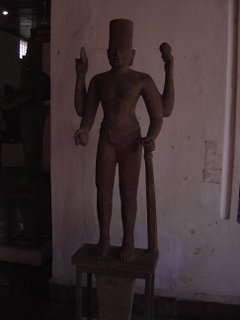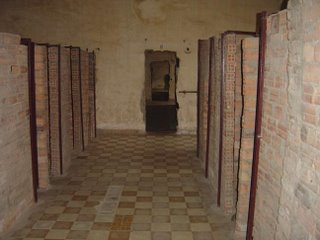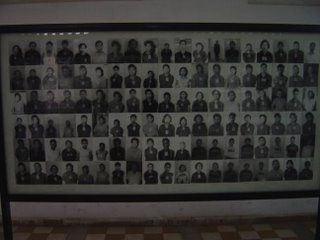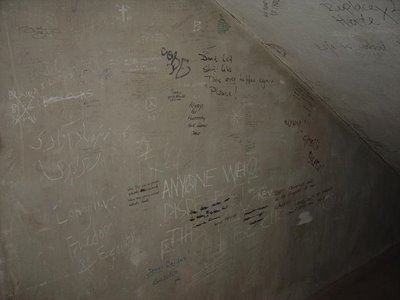Phnom Penh, Ghost Town
 Phnom Penh: at first glance, yet another Indochina city with a delightful blend of French and Asian architecture, containing gems such as this magnificent eight-storey stupa in the middle of a major traffic roundabout in the center of town. On the first morning, walking around the city, there was something very odd about Phnom Penh that I couldn't quite put my finger on. Then it hit me. After seeing several other large Asian cities, Phnom Penh seems sparsely populated. Oh sure, there were lots of times when crossing the street belied this sentiment, or when a sea of kids rushing off off a schoolbus at a busy intersection made it appear dense indeed. But it occurred to me as we passed a row of shops on a major street that had this been Hanoi, there would have been shops in each and every foot of street facing space. In Phnom Penh, there's a creepy amount of elbow room. I found out the population statistics later.
Phnom Penh: at first glance, yet another Indochina city with a delightful blend of French and Asian architecture, containing gems such as this magnificent eight-storey stupa in the middle of a major traffic roundabout in the center of town. On the first morning, walking around the city, there was something very odd about Phnom Penh that I couldn't quite put my finger on. Then it hit me. After seeing several other large Asian cities, Phnom Penh seems sparsely populated. Oh sure, there were lots of times when crossing the street belied this sentiment, or when a sea of kids rushing off off a schoolbus at a busy intersection made it appear dense indeed. But it occurred to me as we passed a row of shops on a major street that had this been Hanoi, there would have been shops in each and every foot of street facing space. In Phnom Penh, there's a creepy amount of elbow room. I found out the population statistics later.Phnom Penh is the capital and largest city of Cambodia, with a population of 850,000 (about the same as Boston proper, not including the surrounding townships). In 1975, the population was well over 2,000,000. Then a guy known as Pol Pot came to power in Cambodia and forcibly evacuated the entire city, relocating the population to rural work collectives, under brutal conditions. In an effort to create an authoritarian, utopian state in record time, he killed more than two million of his own citizens in four years, until the Vietnamese invaded and deposed him. Pol Pot's army, the Khmer Rouge, disproportionately sought out city dwellers and the educated for their victims, although towards the end of the regime, even loyalists were being put the sword in a widening spiral of increasingly arbitrary slaughter. Things got so bad that even the killers themselves started trying to smuggle their own babies out (as depicted in The Killing Fields), assuming that their own turn was surely coming. I won't go into most of the details about the actual deaths themselves, as these are well documented elsewhere and because I have aspirations of small children seeing this blog (if only for the photos!) except to say that the Khmer Rouge sought not to waste bullets.
Obviously, Cambodia still bears these scars- it was less than thirty years ago. When you look around the streets and you see anyone over the age of forty, a question boils at the surface of your consciousness, like some foul potion in a witch's cauldron: where were you in '78? Why did you survive? For most of the people, the answers would be worthy of our sympathy... but the vast majority of the bad guys in this story faced no justice. They're just out there. At least the Nazis had their Nurenberg. Pol Pot himself died an old man a few years ago, having never been brought to trial.
The country has a weird vibe to it. Of course, I'll never know how much of this is me projecting my own feelings about everything I've read, or how much of it might be garden variety cultural differences. The Khmer hospitality is famous, and I definitely saw that in places, but there's a... hardness to this place that is ineffibly disturbing to me, and it's not just the poverty, the beggars, or the touts aggressively hounding you for taxi rides or hotels. Even the survivors have to be affected by the strife in horrible ways. There's just so much scar tissue on this land- literally as well as figuratively. Cambodia is the third most mined country on the face of the Earth- everyone warns you repeatedly that you do not step off the path in the Cambodian countryside for fear of the landmines. The cities and tourist attractions are both rife with amputees, many of them young.*
Here's the national museum courtyard, where we saw some fantastic ancient Khmer art.
 We were guided through the museum by a wonderful woman who clearly had a passion for the art and artifacts, and yet had never in her forty-some years of life traveled the 200 kilometers to see the ruins of Angkor, where we would be going in just a few days, all because of an expense that we considered trivial. The many beggars on the street could not be ignored, but it was at this moment that I realized the vast income differential between the Cambodians and myself. Here was someone articulate, friendly, dressed in an ordinary Western outfit, in every sense a normal individual I would consider my peer, to whom bus fare was an insurmountable obstacle. In the space of a moment, I felt like I had moved several thousand miles further from the US.
We were guided through the museum by a wonderful woman who clearly had a passion for the art and artifacts, and yet had never in her forty-some years of life traveled the 200 kilometers to see the ruins of Angkor, where we would be going in just a few days, all because of an expense that we considered trivial. The many beggars on the street could not be ignored, but it was at this moment that I realized the vast income differential between the Cambodians and myself. Here was someone articulate, friendly, dressed in an ordinary Western outfit, in every sense a normal individual I would consider my peer, to whom bus fare was an insurmountable obstacle. In the space of a moment, I felt like I had moved several thousand miles further from the US.A large number of the steles, lintels and statues of the
 Angkor temples have been moved here for safe keeping, such as this magnificent statue of the Hindu god Vishnu, which I wasn't supposed to photograph. If it's a painting that can be damaged by a flash, I would never skirt the rules in a museum, but this thing is stone.
Angkor temples have been moved here for safe keeping, such as this magnificent statue of the Hindu god Vishnu, which I wasn't supposed to photograph. If it's a painting that can be damaged by a flash, I would never skirt the rules in a museum, but this thing is stone.There were many beautiful things to see in the museum, but it was time to gird ourselves for one of the more brutal tourist attractions of the trip: Tuol Sleng Genocide Museum. I've never been to a Nazi concentration camp, but it can't feel any different than this.
Aside: we discussed visiting the genocide sites of Cambodia with our friend Verena (a fellow traveler whom we met on the boat up the Mekong), who of course had a different perspective than us, having grown up in Germany. Though very polite, she expressed wonder and, I think, a little disgust at our desire to see scenes where the worst in human nature had played itself out. She raised interesting points, and since it had never occurred to me not to go to these places (they were high on my list as soon as I decided to go to Asia) she challenged me to articulate why I wanted to see them.
The best answer I had for her was that the nature of human memory and understanding is to be tied to the senses. This is sad but true: I think I'd prefer a world where I could appreciate the distant suffering of my fellow humans even if I couldn't lay eyes on them, but we all know that's not the way it works. The person in front of you gets your sympathy, the suffering child you actually met haunts your dreams. Perhaps, too, the evil ground on which you tread may make you a more effective engine of good, if only that you might believe in the existence of that evil, remember it, and perhaps recognize it if you ever saw it again.
Tuol Sleng (called s-21 during the Cambodian civil war) was a high school in a densely populated part of Phnom Penh. The Khmer Rouge
 turned it into a prison and torture center in 1975 (what a thing to do to a school). Somewhere I read that the creepy thing about Tuol Sleng is how ordinary it looks: it's clearly just a high school. Everything about the architecture is mundane, until you look inside some of the classrooms on the first floor and see how they've been hastily converted into isolation cells.
turned it into a prison and torture center in 1975 (what a thing to do to a school). Somewhere I read that the creepy thing about Tuol Sleng is how ordinary it looks: it's clearly just a high school. Everything about the architecture is mundane, until you look inside some of the classrooms on the first floor and see how they've been hastily converted into isolation cells.
All of the rooms in one building are full of boards like this one, of the photographs of the victims; the Khmer Rouge shared with the Nazis a passion for recordkeeping. The photos are relentless. There are also lots of pictures from when the facility was liberated by the Vietnamese in '79- less than a dozen people survived, and more than 20,000 prisoners were killed.
The only time in the museum I can say I liked came about by accident. We made a wrong turn at the bottom of a stairwell and happened upon a dead end, with a wall of the most uplifting graffiti I've ever seen. I know it's tough to read in this photo (click on the photos for bigger images) and it may not be eloquent, but it nevertheless made me smile to read "When this was a prison, nobody learned, when this was a school, nobody died."

The main place to which were taken to was outside the city, Choeung Ek, the site of a former graveyard and orchard half an hour south of Phnom Penh. In 1979, a vast number of mass graves were discovered here. Below on the right you see Amy walking between them the pits that have been left over to grass and flowers. In many places along the paths, rain will erode the soil and bits of clothing can be seen rising to the surface. The large stupa on the left is the final resting place of the bones found there.


Lest this end on a purely tragic note, I offer this view of the confluence of the Tonle Sap and Mekong river at sunset, seen from the riverwalk in Phnom Penh.

Next up: the brighter side of Cambodia: the ruins of Angkor.
___
* I cannot resist the urge to politicize here, it's too infuriating. Many of the landmines in Cambodia were manufactured in the United States, a practice that was made illegal during the Clinton administration... and reinstituted in 2004 by his successor. Anyone making money that way needs to come to this country. I encourage you to find out if your mutual fund permits ownership of arms manufacturers- this is, in part, what that means.


0 Comments:
Post a Comment
<< Home